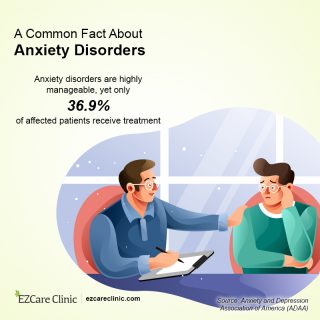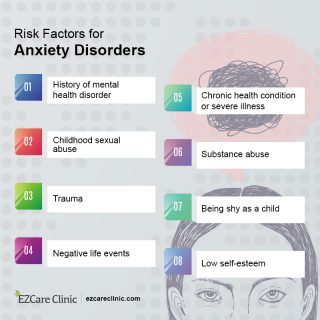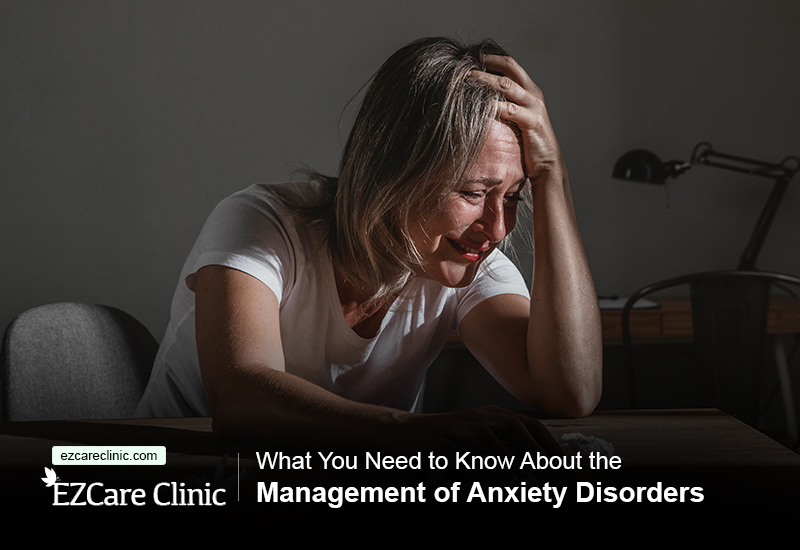It is estimated that more than 40 million people across the U.S. suffer from an anxiety disorder. Most people get past the condition naturally. For some people, however, the condition requires some more effort to get rid of.
You are not alone in battling anxiety. More importantly, however, is that the condition is manageable and treatable.
Get anxiety treated by a mental health specialist by clicking the button below!
What Causes Anxiety Disorders?
Anxiety disorder is a generic condition with many causes, including:
- Exposure to stressful situations, such as a stressful work environment
- Underlying mental conditions, such as depression
- Underlying chronic illnesses, such as cancer
- Exposure to one’s phobias, such as being trapped in a lift or flying
- Withdrawal from drugs, such as is common with recovering addicts
- Side-effects of using certain drugs and medications
- Poor nutrition and negative living, such as smoking and drinking alcohol
These are just some of the common triggers of anxiety. It is important to identify

A Common Fact About Anxiety Disorders
Symptoms of Anxiety Disorder
Anxiety can express itself in many forms, and everyone has their unique ways of coping. Some of the common signs and symptoms include:
- Rapid heartbeat rate
- Sweating, trembling and getting chills
- Difficulty breathing and focusing
- Feeling nervous or restless
The fight is the most common response to an anxiety attack. Interestingly, most people don’t realize when they are suffering from anxiety attacks. Again, it is important to recognize your response to these attacks as it will help with treatment.
Anxiety Management Techniques
There are many remedies for anxiety disorder. Some are fast-acting and temporary, while some can take months for full treatment. Some remedies are easy to perform by yourself, while some will require a visit to the doctor’s office.
Following is an overview of some of the most effective remedies across the board:
· Focused Breathing Techniques
An elevated heartbeat rate is one of the main symptoms of anxiety attacks. It is responsible for flight response and many other symptoms, such as blurred vision. Focused breathing techniques will help bring your heartbeat rate back to normal and get your anxiety attack under control, albeit temporarily.
Focused breathing techniques involve breathing slowly and deeply. Try inhaling deeply for four seconds and then exhale completely for another four seconds. Repeat this for at least five minutes – or until your anxiety attack subsides. It is quick and simple, and it helps deal with surprise anxiety attacks.
Cope with anxiety and other mental illnesses effectively by clicking the button below!
· Therapy
Therapy is the most suitable treatment for anxiety disorder, as well as many other mental disorders. There are various therapeutic techniques applied to this effect. The most effective technique by far is cognitive-behavioral therapy (CBT). It will help you identify your anxiety triggers and responses, and the therapist will also help you develop better, long-lasting responses to these attacks.
Simpler therapeutic techniques, such as aromatherapy, have also been proven to work. Their effects, however, are mild and temporary, unlike CBT, which seeks to establish a long-term cure.
· Proper Nutrition
Your diet may contribute to your anxiety attacks. Your body needs all the necessary nutrients to operate, and lacking these nutrients may influence conditions such as anxiety disorder. Consequently, certain foods are proven to help manage the disorder.
Recommended foods to manage anxiety include green tea, omega-3 fatty acids, dark chocolate, lemon balm, valerian root, and kava kava, among others. Foods generally rich in vitamins will help.
Note: The effects of changing diets take some time to realize. It may take as long as three months in certain cases. It is worth it, however, as proper nutrition is good for your overall health.

Risk Factors for Anxiety Disorders
· Positive Living
Unhealthy habits are often the root of many illnesses, including anxiety disorder. Engaging in excessive drinking, for instance, will disrupt your social life and influence some anxiety attack triggers – the anxiety also lingers when trying to quit.
It is important to quit any bad habits and embrace positive living. This entails, among other things, sticking to a balanced diet, quitting destructive habits such as drinking and smoking, and undertaking projects to improve yourself.
· Sufficient Sleeping
Sleep allows the body to refresh and recharge. Sleep is so important that going for prolonged periods without sleep can make you go clinically insane! As such, it is important to get at least eight hours of sleep.
· Exercising
Exercising is therapeutic. It stimulates the mind and triggers the production of hormones that make one feel calm and relaxed. It also helps with overall health and fitness, and it is a great booster for self-esteem and self-confidence.
Get rid of mental health issues by clicking the button below!
Anxiety is Powerless
There is nothing wrong with you just because you are suffering from an anxiety disorder. It is a mental condition that is easy to manage and treat with anxiety nursing diagnosis. You can do it all by yourself, and you should never be shy to get some help if you feel overwhelmed.
Get in touch with us to treat anxiety disorder through a mental health specialist, book an appointment with us today!





